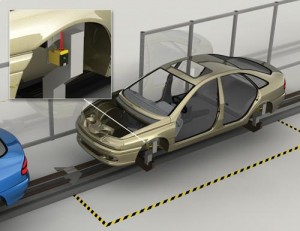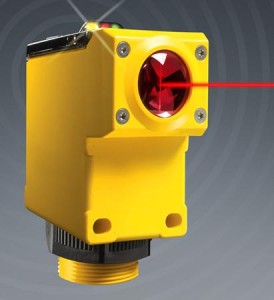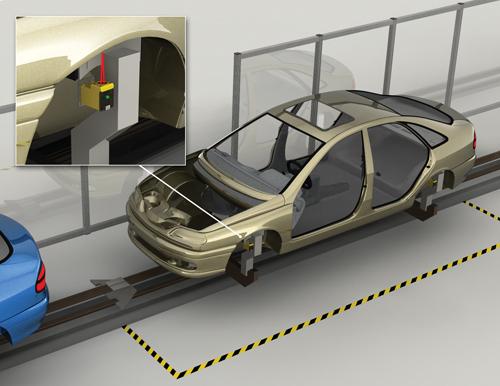
Wireless solutions are making headway in factory control and monitoring applications, driven by the obvious advantages of reducing infrastructure requirements such as cabling, conduit complexities, and installation requirements. The newest entry in this space is what Banner Engineering is calling the world’s first completely self-contained wireless photoelectric sensor.
The SureCross Q45 features a proprietary, self-contained battery, radio, and sensor in an all-in-one package. Using a its own network protocol to optimize bandwidth and power usage, the unit offers communication capabilities of up to 3,000 ft/1 km line-of-sight, and a battery life of up to five years. Banner’s proprietary wireless technology used in the new photoelectric sensors is based on the 2.4 GHz ISM band, and creates a frequency-hopping, spread spectrum solution. The system doesn’t use Zigbee, WiFi, or other standard radio communication architectures because those solutions can’t provide all the characteristics that this application requires.
Specifically, they are not designed for small amounts of data, exceptionally low power, deterministic data transfer, and very long range communications. “The wireless photoelectric solution is only sending a few bits of data over the air with each update,” Bob Gardner, senior product manager at Banner Engineering, told Design News. “The standard infrastructures are designed to handle a lot more data. For example, Bluetooth (which is very inexpensive) is designed to be very short range and typically opens a voice channel which is far more data transfer than the photoelectric system requires. After investigating these other potential solutions, it ends up we can have an order of magnitude better performance if we built a solution from the ground up. Our DX80 wireless system has been on the market for more than five years, and it’s the technology we have used in the new Q45 sensors.”
A key to the design is that the wireless photoelectric sensor requires 2,000 times less power than a cellphone. Compared to a standard photoelectric sensor, the cost premium for the wireless solution is less than the cost to hard wire the system. To achieve the five-year battery life, the design also needed to reduce the power required to operate the sensor over a thousand fold on what was already a low power sensor. One technique used to reduce power consumption is to quickly turn the sensor on and off.
“We made the sensor very fast so it could take a reading in a fraction of a millisecond. Then, we can turn the sensor off for, say, 100 milliseconds,” Gardner told us. Many times a second, the sensor is turned on and operated for a very short period, but the majority of time it is essentially off. Sophisticated algorithms within the sensor control when it is using power.
Application advantages and limitations
“If a customer is trying to implement a system with millisecond or sub-millisecond operation which could be categorized as high speed, wireless is not what you want,” said Gardner. “A wired system is still faster for those types of applications with more brute force power available.” But if the application has long cable runs and more real-time performance requirements, versus high-speed operation, Gardner said the wireless sensors typically respond in 125 milliseconds.

Wireless is also suited for applications where there is motion between the PLC and end device such as a transport mechanism or conveyor. A wireless system design is much less expensive than implementing slip rings using cable trays and flexible cables. Another application advantage is if the sensor is located a long distance from the control. On a small machine where the distance is only five feet, it may not make sense, but if the distance is 500 feet, installing the wireless sensor costs less than installing the cable.
A potential application class is where there is a requirement for system-wide monitoring such as a call-for-parts system, for example, that delivers a tote of parts to a location. Wireless is often used on forklifts, so that the driver can have an indicator and real-time feedback, which identifies which areas are out of parts. Since the forklift is mobile, wireless offers a clear advantage.
Many manufacturing facilities are looking to create flexible layouts where production can be laid out for specific needs depending on their product mix. To collect information from a machine used in the process that might be moved on a periodic basis, wireless works well since you can move the machine without a need to rewire it. One potential application concern is system reliability, but Gardner said that has been a focus of the design process. The signal used is extremely robust, powerful, and provides 10 to 100 times the range of a WiFi-based system, and also has built-in all of the characteristics of a PLC-based level network. This includes time-out mechanisms, CRC checks, and a pre-defined state for the output in case a link is lost.
For years, these techniques have been used in PLC level networks and have also been built into the wireless protocol. With its built-in site survey, which reports signal strength, if everything is set up properly and within range to guarantee good signal strength, the system is as reliable as a wired solution. It also provides immediate indication if communication is lost to a part of the system, and has been designed with the reliability and determinism issues firmly in mind.
The system can also implement a system heartbeat where wireless devices check on a regular basis, every five seconds, for example. If the devices don’t check in, those devices can be reset to a pre-defined state to fail in a predictable manner.
Banner Engineering has a lot of experience with the wireless system technology, but the breakthrough with the Q45 is a combination of low power operation, fast response, and the way it has been implemented as a tightly defined product. The unit provides the sensors, batteries, power management, and the wireless system all in a single housing. “All the user needs to do to establish communications is bind it to a gateway. Since there can be multiple gateways and devices in a single area, communications only occur with devices that they have been paired with,” Gardner told us.
He said engineers are sometimes concerned with noisy devices such as variable frequency drives (VFDs) operating in the same area. Noise can reduce the range of the signal, but not significantly. The wireless system has a very narrow band that it is operating within. Frequency-hopping, spread spectrum technology creates a very narrow, well-defined frequency, and these narrow frequencies are very noise immune because the system can filter out any frequencies above and below that level. Engineers can also be concerned if it will affect their WiFi system since the sensor and laptops both operate at 2.4 GHz. But all ISM band products are certified to work well together, and Gardner said extensive testing has shown the two technologies don’t affect each other at all.
Customers have done extensive testing for WiFi interference but none of them have been able to sense the wireless sensor operating on the network. Because the system is sending just a few bits of information every 125 milliseconds, it is creating much less traffic than other WiFi devices. A PLC on the system using a WiFi radio access point to pick up the sensors, for example, would require 1,000 times more bandwidth than the Q45 system.
Source: http://www.designnews.com/author.asp?section_id=1386&itc=dn_analysis_element&doc_id=261150&page_number=1





